Last Chance to Catch NYC's Holiday Notalgia Train
We met the voices of the NYC subway on our nostalgia ride this weekend!


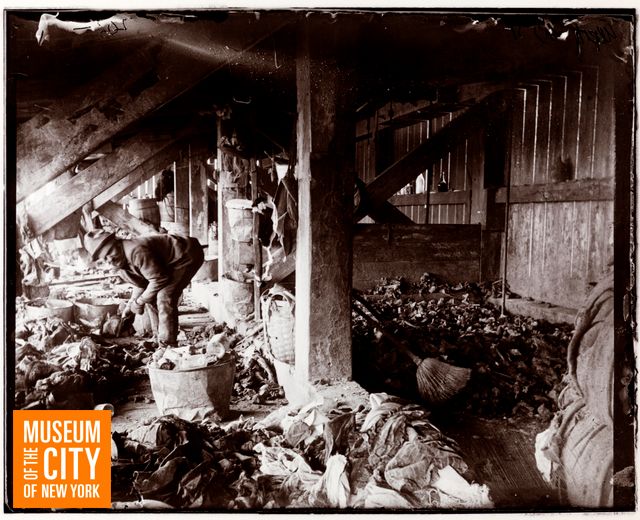
A central highlight of the comprehensive exhibit
Here is a sampling of Riis’ photographic haunts, featured in the current exhibit:

The New York Tribune press office at 301 Mulberry Street. Photo by Jacob A. Riis, Museum of the City of New York Collection
For eight years, Riis worked the overnight beat for the New York Tribune in the press office at 301 Mulberry Street, located conveniently near the local police station. Though now part of fancy Noho, this area was once known as Cat Alley, and Riis would recount the clean-up efforts here (and other areas) his book The Battle With the Slum.
The wood-framed buildings of Cat Alley and the vicinity photographed by Riis no longer stand today, demolished as part of a street extension project in the late 1890s.
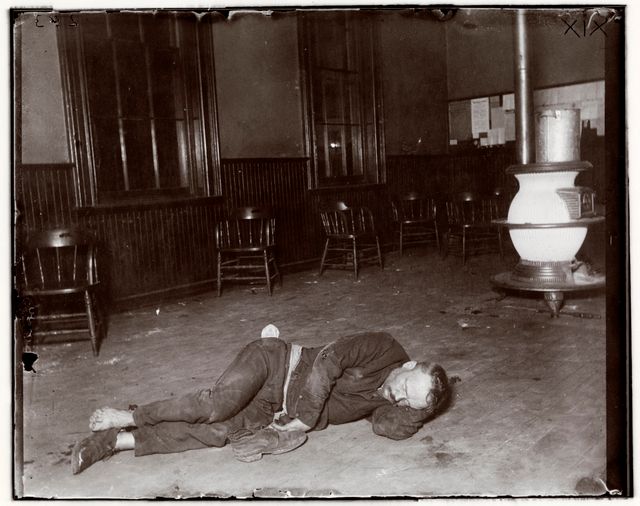
Photo by Jacob A. Riis, Museum of the City of New York Collection
Pictured above is a typhus lodger, lying on the floor by the stove of the police station lodging house on Eldridge Street. Lodging house types ran the gamut and Riis describes the options in How The Other Half Lives:
There are no licensed lodging-houses known to me which charge less than seven cents for even such a bed as this canvas strip, though there are unlicensed ones enough where one may sleep on the floor for five cents a spot, or squat in a sheltered hallway for three. The police station lodging-house, where the soft side of a plank is the regulation couch, is next in order. The manner in which this police bed is “made up” is interesting in its simplicity. The loose planks that make the platform are simply turned over, and the job is done, with an occasional coat of whitewash thrown in to sweeten things.
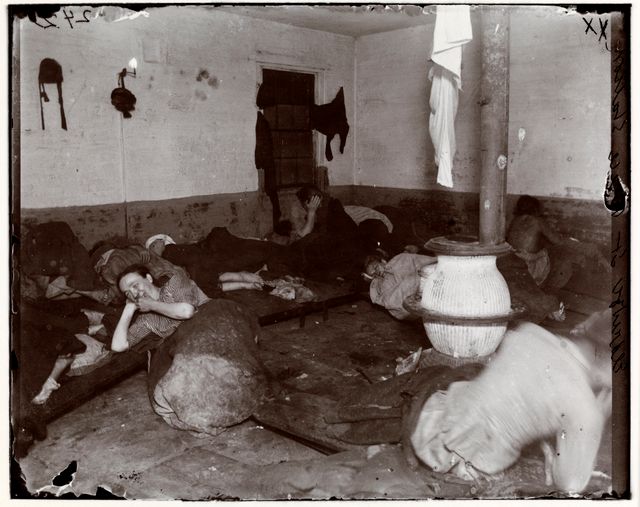
Women lodgers at Eldridge Street Station circa 1890. Photo by Jacob A. Riis, Museum of the City of New York Collection
Above is a photograph of the women’s room of the police station lodging house on Eldridge Street, where they slept on plank beds and the floor. The 1886 Municipal Lodging House act gave the city ability to operate homeless shelters but these were not open to “women, children, the elderly or the infirm” who sought refuge in police stations and other locations.
As exhibit curator Bonnie Yochelson writes in the book Rediscovering Jacob Riis: Exposure Journalism and Photography in Turn-of-the-Century New York, Riis’ photographs inside New York City’s police station lodging houses represent “his most extensive documentation of a single subject,” spurred by Riis’ own horrifying experience inside one himself shortly after arriving to the United States.
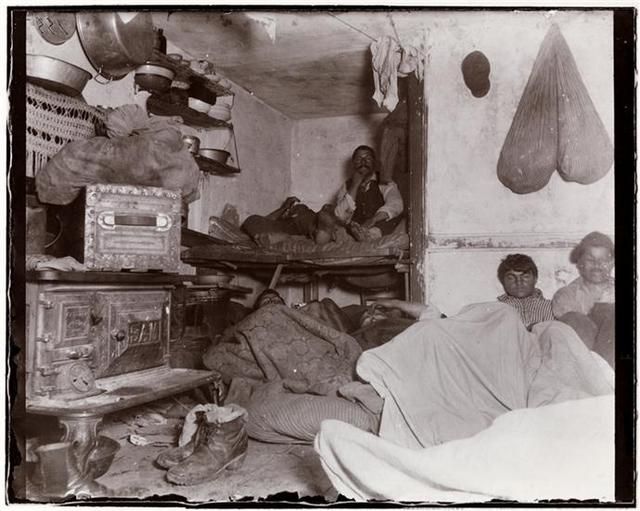
“Five Cents a Spot” circa 1890. Photo by Jacob A. Riis, Museum of the City of New York Collection
In modern-day Chinatown, Jacob Riis photographed lodgers in tenement apartments like the above on Bayard Street near Mulberry Street. As Riis writes in How The Other Half Lives, “5 Cents a Spot” refers to the price paid for a place to stay, likely on the floor since the legal minimum charge was actually 7 cents a spot, which came with a bed. Riis uses the title of the photograph to denote the illegality of the the lodging house pictured.
The famous photograph shows Riis’ use of flash photography. Though the room was in near pitch darkness, “[Riis] barges in, says exhibit curator Bonnie Yochelson, “takes a picture with the flash, scares the living daylights out of the people – you can see it in their faces – the flash actually makes a burst of light and a boom – so it’s terrifying. Those were the first pictures.”
Riis also explored the opium dens of Chinatown, as seen in this image taken between 1877 and 1888:

“Chinatown, Smoking Opium in a Joint,” photo by Jacob A. Riis, Richard Hoe Lawrence, and Dr. Henry G. Piffard. Museum of the City of New York Collection
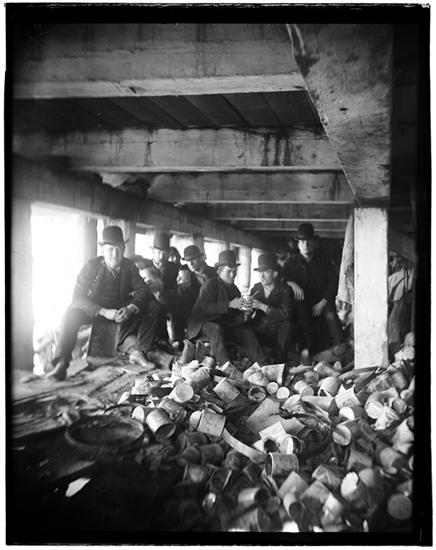
Photo circa 1890 by Jacob A. Riis, Museum of the City of New York Collection
Riis’ reform initiatives extended beyond housing to topics like crime and social ills. This photograph of the Short Tail Gang is taken at under the pier at Corlears Hook, an area that has since been infilled and renamed Corlears Hook Park. The Bowery Boys describes the Short Tail gang as a “particularly nasty gang of criminals who terrorized the Lower East Side” with a particular penchant for beer. This photograph by Riis (the uncropped original shows even more mugs) captures the extent of the gang’s beer obsession, fueled and financed by many of their violent crimes along the waterfront.

Photo by Jacob A. Riis, Museum of the City of New York Collection
Bandit’s Roost was an alley off Mulberry Street, near Riis’ office across from police headquarters. The casual posed nature of the people in the foreground likely suggests some form of complicity and familiarity between subjects and photographer – which is certainly possible given the proximity of the alley to the office.

Photo by Jacob A. Riis, Museum of the City of New York Collection
While investigating a murder at the East River dump, Riis discovered that a group of Italian men and boys had taken up residence there. For an article for The New York Sun entitled “Real Wharf Rats: Human Rodents That Live on Garbage Under the Wharves,” Jacob Riis visited numerous of the city’s garbage dumps – Rivington Street, Rutgers Street, West 35th Street, and West 47th Street. The above photograph shows a “wharf rat” scavenging under the 47th Street dump in Hell’s Kitchen.

Little Katie from the West 52nd Street Industrial School, 1891-1892. Photo by Jacob A. Riis, Museum of the City of New York Collection
Riis evolves his strategy after his book How the Other Half Lives. In The Children of the Poor he begins to incorporate data and statistics behind child mortality, public health and education rates – information he gets from a friend who works as a statistician at the New York City Board of Health. Correspondingly, he also reverses his photographic strategy. Instead of surprise flash visits, Riis “meets the child, and talks to the child, and is a reporter. And then in his writings, it’s a word and picture portrait,” describes Yochelson. The above portrait of “Little Katie” was taken at the West 52nd Street Industrial School, established by the Children’s Aid Society.

Newsboys Sleeping in the Offices of the New York Sun, 1891-1892,” photo by Jacob A. Riis, Museum of the City of New York Collection
Newspaper Row was once located on Park Row, just alongside City Hall and City Hall Park. It was home to such institutions as The New York Times, The New York Tribune and The New York World who were building some of the tallest buildings in the world as their headquarters. The city’s newspapers were originally distributed primarily by newsies – poor or homeless city children – who purchased newspapers from the publishers and sold them on the streets. Riis documented the newsies inside the New York Sun building, and the above is one of several showing them sleeping.
In 1899, the newsies staged a boycott against Joseph Pulitzer and William Randolph Hearst, maching onto the Brooklyn Bridge and stopping traffic for hours. In the end, the publishers agreed to buy back any unsold papers.
Next, check out 10 Highlights of the Exhibit Jacob Riis: Revealing New York’s Other Half at Museum of the City of NY and read our walkthrough of the exhibit with MCNY Curator Bonnie Yochelson. On your visit to the museum, also check out “Affordable Housing: A New York Legacy.” .
Subscribe to our newsletter